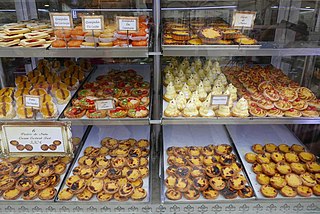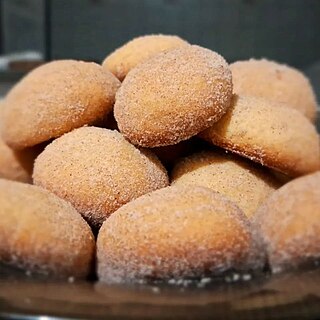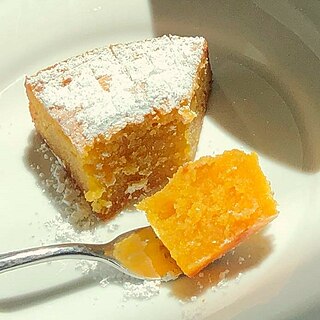
Dessert is a course that concludes a meal. The course consists of sweet foods, such as cake, biscuit, ice cream and possibly a beverage such as dessert wine and liqueur. Some cultures sweeten foods that are more commonly savory to create desserts. In some parts of the world there is no tradition of a dessert course to conclude a meal.

The oldest known book on Portuguese cuisine, entitled Livro de Cozinha da Infanta D. Maria de Portugal, from the 16th century, describes many popular dishes of meat, fish, poultry and others.

Portuguese sweet bread refers to an enriched sweet bread or yeasted cake originating from Portugal. Historically, these sweet breads were generally reserved for festive occasions such as Easter or Pentecost and were typically given as gifts. However, in contemporary times, many varieties are made and consumed year round. Outside of Portugal, Portuguese "sweet bread" translated as "pão doce" is often associated with Azorean "massa sovada" which are similar but traditionally prepared differently.

Cucurbita ficifolia is a species of squash, grown for its edible seeds, fruit, and greens. It has common names including Asian pumpkin, black seed squash, chilacayote, cidra, fig-leaf gourd, Malabar gourd and Kahurura in Gikuyu. Compared to other domesticated species in its genus, investigators have noted that samples of C. ficifolia from throughout its range are relatively similar to one other in morphology and genetic composition. Variations do occur in fruit and seed color, some isozymes, and photoperiod sensitivity.

Knafeh is a traditional Arabic dessert, made with spun pastry called kataifi, soaked in a sweet, sugar-based syrup called attar, and typically layered with cheese, or with other ingredients such as clotted cream, pistachio or nuts, depending on the region. It is popular in the Middle East.

Baklava is a layered pastry dessert made of filo pastry, filled with chopped nuts, and sweetened with syrup or honey. It was one of the most popular sweet pastries of Ottoman cuisine. It is also enjoyed in Arabian, Persian & Greek cuisine.

Quince cheese is a sweet and tart, thick jelly made of the pulp of the quince fruit. It is a common confection in several countries.

Fios de ovos is a traditional Portuguese sweet food made out of egg yolks, drawn into thin strands and boiled in sugar syrup. It is used as a garnish on cakes and puddings, as a filling for cakes, or eaten on its own.

Cabell d'àngel is a transparent threaded jam made from Siam pumpkin pulp and white sugar. It originated in Mallorca but its use has spread to the rest of Spain and some countries in the Americas.

Conventual sweets are a typical part of the Portuguese cuisine and a generic term to a variety of sweets in Portugal. As the name implies, conventual sweets were made by nuns who lived in the Portuguese convents and monasteries. Starting in the 15th century, these sweets have since integrated in the Portuguese cuisine and in former Portuguese colonies. Conventual sweets have sugar, egg yolks and almond as ingredients of choice.

Pão de Rala is an historical conventual dessert created by the Poor Clare nuns in the Convento de Santa Helena do Calvário in Évora. It is often accompanied by olives shaped out of marzipan and dusted with cocoa, per legend.

Azevias are traditional Portuguese fried pastries, turnovers filled with a sweet filling.

Areias are small traditional Portuguese pastries similar to cakes and biscuits. They are commonly coated with coarse-grain sugar, and sometimes cinnamon, which resemble sand for which areias are named after.

Toucinho do Céu is a Portuguese dessert made primarily of almonds, eggs, and sugar. While it is often described as a cake or tart, toucinho do céu remains largely free of flour and should not be mistaken for other Portuguese cakes and tarts containing almonds.

Sericaia is a Portuguese pudding similar to a soufflé, from Elvas, Alentejo. It is often accompanied with stewed Reine Claude plums grown in the region.

Encharcada is a traditional Portuguese conventual sweet of egg yolks boiled in sugar syrup and then broiled.

Barriga de freira is a traditional Portuguese sweet egg yolk-based pudding. The name is an idiom on the ingredients typically found in conventual sweets made by the religious sisters at convents historically―egg yolks, sugar, and almonds. Another variation of barriga de freira is served as a turnover or empanada using the same pudding for a filling.






















